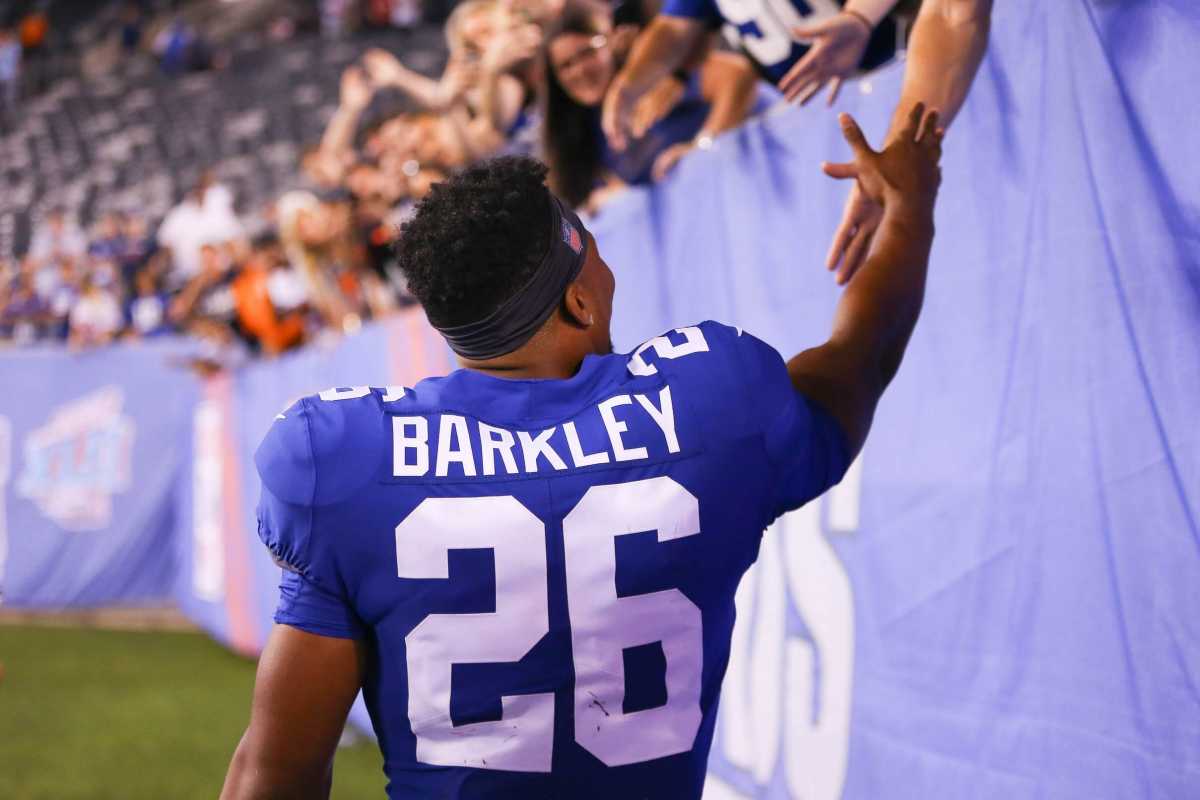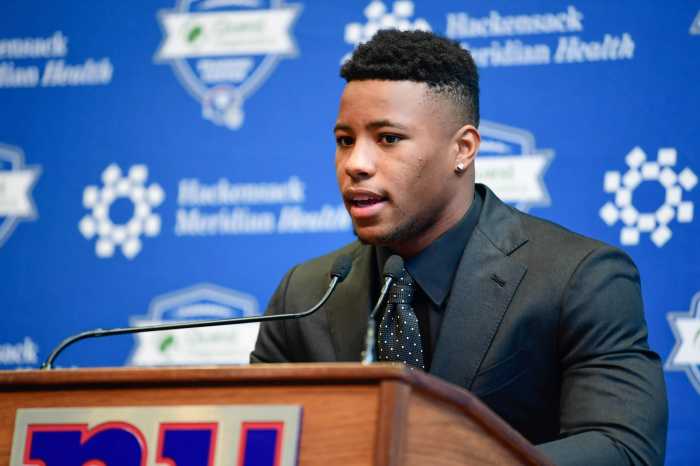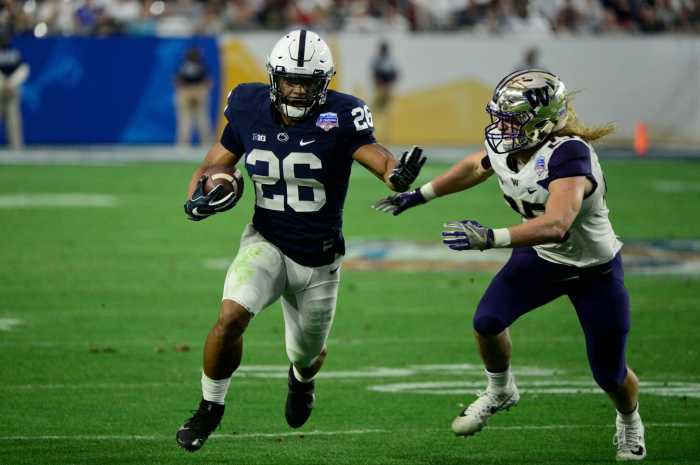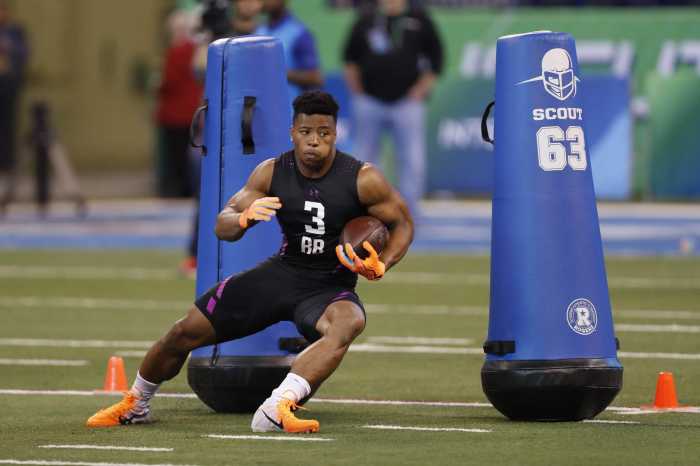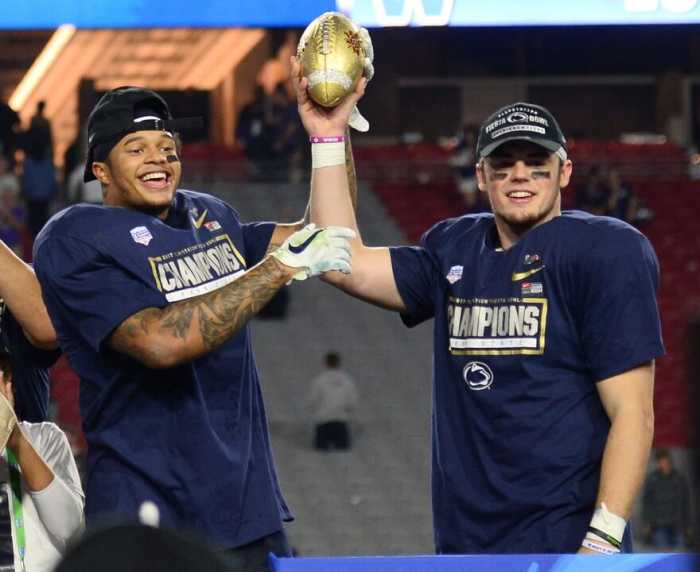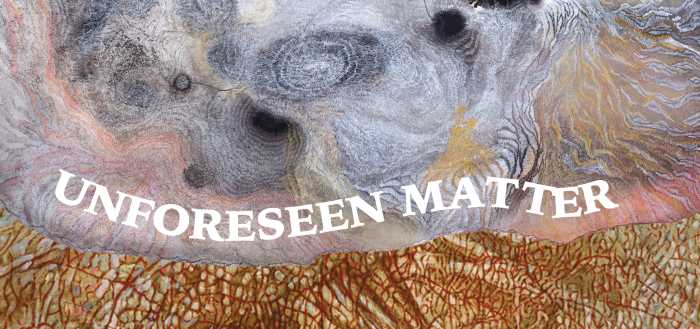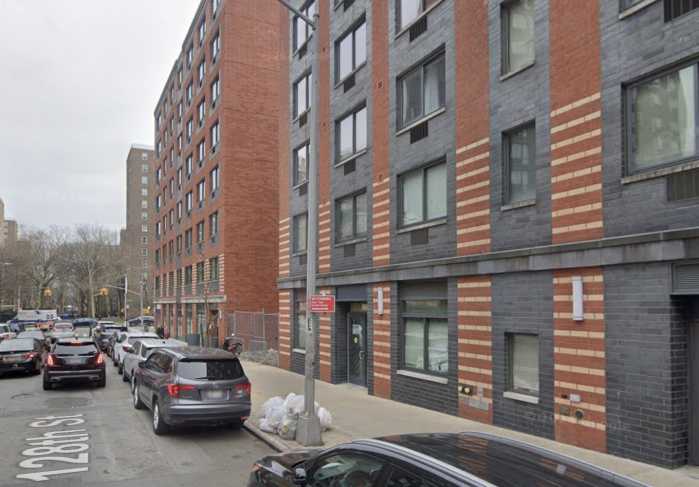Hello Eagles’ fans, I hope you’ve been enjoying the preseason as much as I have — despite some worrisome performances from our offence. Today we’ll be diving into a crucial element of our rival’s offence, their coveted new addition acquired with the number two overall pick. The Giants’ haven’t had a potent rushing attack in years, is the Penn State alum the answer to their prayers? Let’s take a look.
The biggest change in big blue’s backfield is the addition of the 2nd-overall pick: super-human, all-around running back Saquon Barkley. Averaging 5.72 yards per carry in college, the Penn State product also tallied 3843 yards, 51 total touchdowns and 773 receiving yards over three years. However, regardless of the arrival of one of the best running back prospects in recent years, the success of this run game will hinge on the new-look offensive line. We will be tackling the line in full next article. As a cohesive unit, the New York Football Giants were not successful running the ball under Ben McAdoo. They finished 26th and 29th in total rushing yards in 2017 and 2016, respectively. Lacking first round talent in the backfield may have been the least of their problems. Orleans Darkwa ran for 4.4 yards per carry on the season and 2017 rookie Wayne Gallman turned in 4.3 yards a click. It was likely the struggling offensive line and blasé play calling at the heart of the struggles.
Former head coach McAdoo and Steve Spagnuolo’s run calls often directly countered the team’s biggest strengths. Over the last two seasons, the Giants ran the ball through the center of the defense 67% of the time. The league average was 55%. In 2017, a league high 66% of the team’s runs went up the middle, despite gaining only 3.97 adjusted line yards per carry in that direction – 25th in the league. The Giants ran the ball up the middle more regularly last season than the Jacksonville Jaguars. This makes even less sense when considering the running backs on last year’s roster. Granted, Wayne Gallman does have some size to him. Nevertheless, using a power-based scheme with smaller one-cut backs, and without a designated fullback on the roster to mask shortcomings is not a recipe for success. Contrary to their failures running up the middle, they were the second most efficient running team when pounding the ball behind former right tackle Justin Pugh, now with the Arizona Cardinals – gaining 5.07 adjusted line yards per carry to the outside right. Accordingly, in counter-intuitive McAdoo fashion, they ran to the right side 17% of the time: below the league average of 22%. New Head Coach Pat Shurmur is regularly accredited with a creative rushing attack, finding imaginative ways to get his play makers the ball in different positions. Nevertheless, few NFL teams have success running the ball compensating for weak blocking with gadget plays. A transition to a more zone based running scheme should better play to his personnel.
All that being said, the Giants’ offensive line wasn’t actually that bad last year. Admittedly, the tape is worse than the numbers are. However, despite regularly being stopped on third-and-short, they were a very average run-blocking team. Compared to the league’s top rushing attack, the team’s adjusted line yards (4.06) were barely below the league leading Jaguars (4.12). What might be surprising to most is that they matched up comparatively with Shurmur’s old team the Minnesota Vikings. The Vikings were considerably better on third-and-short and consistently getting to the second level of the defense, but sacrificed some negative plays in doing so. Below is a chart comparing the Giants to Minnesota, as well as the top rushing teams in the past two years (Jacksonville, Buffalo), and some teams who had success with first year running backs (Jacksonville, Kansas City, Dallas).
| Team | Adj. Line Yards | RB Yards | Power Success | Stuffed
Rate |
2nd Level Yards | Open Field Yards | RB Att | Total Rush Yards |
| 2017 NYG | 4.06 (15th) | 4.02 | 50% (29th) | 17% (6th) | 1.02 (24th) | 0.68 (18th) | 369 | 1549 (26th) |
| 2017 MIN | 3.96 (19th) | 3.98 | 67% (10th) | 21% (19th) | 1.11 (17th) | 0.77 (13th) | 447 | 1957 (7th) |
| 2017 JAX | 4.12 (13th) | 4.16 | 62% (19th) | 19th (10th) | 0.98 (27th) | 0.96 (7th) | 464 | 2262 (1st) |
| 2017 KC | 4.14 (12th) | 4.66 | 82% (1st) | 18% (8th) | 1.23 (9th) | 1.17 (2nd) | 314 | 1903 (9th) |
| 2016 NYG | 3.89 (24th) | 3.70 | 63% (14th) | 17% (9th) | 1.01 (29th) | 0.40 (29th) | 372 | 1412 (29th) |
| 2016 BUF | 4.16 (16th) | 5.12 | 60% (20th) | 22% (22nd) | 1.41 (1st) | 1.32 (2nd) | 382 | 2630 (1st) |
| 2016 DAL | 4.63 (4th) | 4.68 | 73% (3rd) | 15% (5th) | 1.36 (5th) | 0.98 (8th) | 426 | 2170 (2nd) |
Employing a power-run scheme helped big blue not lose yardage. The low stuffed rate is indicative of the attitude towards the New York run game – just try not to make it worse. Similar to the Redskins, the Giants just didn’t run the ball enough to be a top rushing attack. You could reasonably argue a chicken-and-the-egg scenario. If the team is to improve in 2018, the key will be 2nd level and open field yardage. Jacksonville’s 2nd level yards are skewed due to their high number of rushing attempts – they ran the ball 527 total times in 2017, compared to 405 times for Kansas City and 394 times for the Giants. Nonetheless, successful rushing teams have one thing in common: they are able to get to the second level of the defense. This is an area where the rookie will help immediately. 57% of Barkley’s rush yards in 2017 came on “break-away” plays of more than 15 yards. That was his third straight season at Penn State with over 50% of his yards coming on break-away plays. As you’ll see below, he was able to achieve that level of success without a top-tier offensive line.
| Penn State | Athlon Sports Ranking | Opportunity Rate | Power Success | Stuffed Rate |
| 2017 | 27th | 43.9% (9th) | 89th | 21.3% (95th) |
| 2016 | Not Ranked | 38.2% (84th) | 118th | 23.9% (119th) |
| 2015 | Not Ranked | 38.2% (78th) | 122nd | 25.1% (120th) |
Opportunity rating is based on whether or not the offensive line has given the running back the opportunity to achieve the yards of a “successful” run play – based on the average for the nation.
While brief, the new back’s few preseason runs in royal blue gave a telling peek at his ability, and of what to expect from the O-line. On the first run of his NFL career – slow motion at 0:18 – the offensive linemen make a decent original push, and then proceed to watch as Saquon makes four defenders miss. I realize this is pre-season, but nobody seems overly eager to make a block downfield. 0:40 is a good example of what will happen if Barkley is not able to create for himself. The speed of the edge rusher and inability of the tight end to make a block of any kind completely negates the stretch zone run. This was a staple of Minnesota’s run game in 2017 and something Barkley ran a lot at Penn State. In the search for “hog mollies”, the Giants have made themselves a bed of big, strong, but slow lineman; and now they must lie in it. It must also be said that Evan Engram is not a strong blocking tight end. It is the run at 1:03 that I think is most indicative of what Saquon will struggle with at the professional level. Instead of using his 235-pound frame to take on the linebacker in the hole, he bounces outside and gets a much-harder-earned 2 yards. Accustomed to being the best athlete on the field at all times in college, Barkley will have to get used to taking the easy yards. In fact, this is one of the running back’s biggest, if not only criticism. For better or worse, he is a home-run hitter.
The aforementioned 57% break-away yards came on just 19 plays. That means 19 carries made up 57% (approximately 725 yards) of Barkley’s 1271 rushing yards. The other 198 carries? 546 yards; 2.7 yards per carry. That is despite a 43.9% opportunity rating from his offensive line. Speaking to the disparity of opportunity rate to stuffed rate: being a big-play player, Saquon will often take a loss while trying to make too much happen in the backfield. In his final year at Penn State, he averaged less than 3 yards per carry in three different games and led the nation in runs of negative yards. Due to the Penn State run scheme, he often ran stretch plays and was forced wide – naturally resulting in more negative plays. Last season coach Shurmur hung his hat on inside zone runs, but included a fair share of stretch runs. Barkley averaged 4.9 yards per attempt on inside zone runs in college. Nevertheless, he was hit behind the line of scrimmage on 44.5% of his carries (3rd highest among draft eligible running backs). The problem is he averaged an awful 0.46 yards per carry when contacted behind the line. The only successful NFL runner that fielded similar stats coming out of college was LeSean McCoy. Barkley is not as slippery as “Shady”, and also outweighs him by almost 25 pounds. You’d like him to be able to break out of some of those tackles. Due to all the negative plays, Barkley was only able to surpass the 100-yard mark in fifteen games over three years; he had the same amount of games with under 70 yards. Quite similar to Jay Ajayi’s time in Miami, Barkley may have a few awe-inspiring, mind-bending splash games, and a whole lot of very average games. At the end of the day, he is still able to do stuff like this:
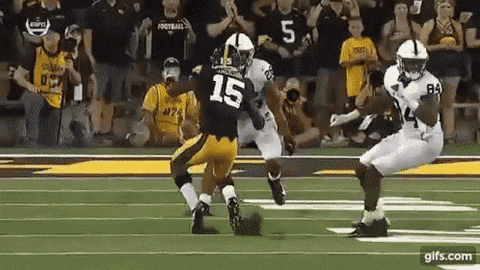
In accordance with a varying carry total, some question the Penn State alum’s ability to support an NFL load on a regular basis. Whether he is ready or not, Shurmur will likely give him all the opportunities he can handle. In the 3.5 games he was featured in, 2017 Viking’s rookie Dalvin Cook played 75% of offensive snaps. He was really only taken off on third and long scenarios. In the red zone, he was on the field for 21 of 25 snaps and received 8 of 9 carries. Being a coach that schemes to his player’s strengths, I could see Shurmur keeping Saquon on the field for passing downs. The back averaged 1.7 yards per route run (17th among draft eligible running backs), and is a more-than-serviceable pass blocker. This will leave very few opportunities for the other backs on the roster, barring injury.
The Giants brought in veteran Jonathan Stewart from the Carolina Panthers to attempt to add some wisdom to the room. In my opinion, he brings nothing else to the table. That may seem like a harsh statement for a man who ran for 680 yards last season, but he also averaged a career low 3.4 yards per carry. He has had over 200 yards receiving in a season only once in his 10-year career, and he hasn’t had a 1000-yard season since 2009. Not that the front office brought him to New York to be a 1000-yard rusher. Stewart is supposed to be a specialist against stacked boxes – he led the NFL in facing 8+ men in the box last season (51.1%). Firstly, that’s mostly due to his absolute inability to be a factor on anything but a dive. Secondly, he was less effective against stacked boxes last season than his much-younger, more athletic teammate Wayne Gallman. He may vulture some touchdowns, but I don’t even think he’s the Giants’ best option on the roster for 3rd-and-short. Not to make a mountain of a molehill, but below are Stewart’s preseason stats so far this preseason.
| Carries | Yards | Long | Fumbles | |
| CLE | 3 | 3 | 4 | 0 |
| @DET | 4 | -1 | 3 | 0 |
| @NYJ | 3 | -7 | 1 | 1 |
Second-year pro Wayne Gallman made more of a splash last season than most expected. His season totals were: 111 carries, 476 yards, 4.3 yards per carry, 34 receptions, 193 yards receiving, one touchdown. It may be all for naught with the addition of Barkley. However, he may see play on obvious passing downs as a pass blocker. According to Pro Football Focus, Gallman allowed only one hurry and one pressure on 29 pass blocking snaps last season – 8th best for eligible running backs. The young back’s playing time will be hampered by his struggles as a pass catcher. He had 3 drops on 48 targets last season. So far this preseason, his abilities have looked much improved. Against the Browns he had 33 yards receiving, and added a rushing and receiving touchdown against Detroit. He may have done enough to carve a small role for himself, especially if Saquon misses any time.
https://www.youtube.com/watch?v=wD0kpiixrz0
Best Case: Giants fans would expect me to spout something in the neighborhood of Ezekiel Elliot’s rookie rushing numbers. Realistically, it will be tough for Saquon Barkley to reach 1500 yards. If he does, it will be on the shoulders of some extraordinary single-game showings. Just as the Dallas offensive line is constantly touted for elevating Elliot’s game, the opposite may be true in New York. Best case scenario is 1,300 yards rushing. However, I think he’s capable of adding another 500 yards receiving – something Elliot did not do. This scenario would take a big showing from rookie Will Hernandez and an uncharacteristic improvement from Ereck Flowers. The best-case scenario is a difficult one to figure for Wayne Gallman. He deserves some playing time, but it’s less a factor of him earning it as much as Saquon losing it. Maybe Stewart will convert some crucial third downs and goal line touchdowns.
Worst Case: It is a realistic possibility that Barkley will not crack 1000 yards rushing on the season. There are a lot of questions surrounding the Giants’ rushing attack heading into 2018. Is the coaching staff willing to give Barkley 205+ carries? The last time Pat Shurmur-lead offence gave 250+ carries to their top rusher was 2014, when he and LeSean McCoy were still in Philadelphia. Can Saquon cut out the negative plays, and will the offensive line hold? Those are questions that have yet to be answered. Add that to the fact that the Giants face the league’s second toughest schedule for rushing offences: 850 yards rushing and 350 yards receiving is what I predict if all goes south for a second year in a row.
Mandatory Credit: Vincent Carchietta-USA TODAY Sports

